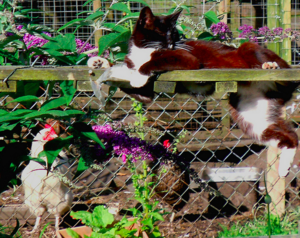
As adorable as felines are, they're sometimes a nuisance when they dig, urinate on, sleep on and squash plants in the garden. Fortunately, there are things you can do to discourage them from using your veggie plot or flowerbed as their fun patch. Here are a few suggestions, feel free to add many more.
Using smells cats don't like[edit | edit source]
Dry orange peels, chop finely and sprinkle the pieces through the garden area. Many cats don't like the smell of oranges. Beware though, as some cats couldn't care less and don't mind the smell at all.
There are some herbs that cats are said not to much like. These are: Pennyroyal, lavender and rue.[1] These can be planted in the gaps in the garden bed, and even if the smell doesn't deter them, the fact that plants are growing in the way should help.
Make a cat deterrent spray.[1] Place 1 teaspoon of powdered black pepper, 1 teaspoon of ground cinnamon and 1 teaspoon of dry mustard into a spray bottle. Add a few drops of pure essential citrus oil and one crushed garlic clove. Fill with water and shake well before use. Spray in those areas of the garden where you don't want the cats to dally. Best used in conjunction with leaving the cats somewhere else to laze about.
Barricading the garden[edit | edit source]
Make the garden space you're trying to defend a cat unfriendly location. Some things to try include:
- Put upturned terracotta spots or saucers in spare spaces and next to fragile seedlings to discourage cats from lying on those spots and squashing the plants.
- If you have pine cones in your garden or area, use these to form little barrier fences around young seedlings. As a bonus, the birds will find it harder to get at the mulch or seedling when a little pine cone fence is around the seedling. Remove once the plant grows large enough to be safe from getting squashed.
- Use prickly plants as ground protection. Just as humans dislike being pricked by rose, holly leaves or berry thorns, cats have sensitive paws too. If you have rose clippings, blackberry or other berry stalks, cut them into smaller pieces and arrange under the bushes you don't want the cats visiting. However, cats will work out a way if you let the weeds grow over this prickly deterrent, so you will need to carefully keep weeding it. And a warning - it hurts if you manage to dig your own fingers into it while weeding.
- Lay chicken wire or similar mesh over the garden bed. Cats don't like their paws being splayed by such ground covering.
Deflecting the cats[edit | edit source]
Make the cat space in the garden of its very own, to encourage it to stay there and away from other areas where the productive growing is going on. This could include:
- Growing catnip, lemongrass, cat grass and other types of herbs and plants beloved by cats.
- Leave plenty of enticing sun-soaked space for the moggies to lie down and bask in the sun in this deterrent garden. Lay down some pea straw for lying on, or leave exposed soil, depending on what your cats seem to prefer.
- Tall grass is much loved by many a cat, so consider leaving an area of this tiger-safe zone in the garden for your moggies to roll about and hide within. Here is a great excuse to not weed one corner of your garden. Just be sure it gets some sun though; cats don't like being deprived of their basking opportunities.
- Provide your cat with its own above-the-garden walking and sleeping area. Build a little boardwalk in cat size that goes over the garden and a sleeping spot next to the garden space so that the cat can still be a part of your gardening activity but surveying above it, which cats love.
- Till a dig and poo area. Leave it to the cats. Don't get upset about the fact they're using it. At least you know where they're doing their business. If you want to collect and dispose of their poo, make a sandbox solely for the cats to use, and empty it regularly.
Talk to your cat(s) when in the garden. Use a soothing and calm voice to tell them to leave the garden alone as you pick them up and put them somewhere else. If you make an effort to connect with the cat, without getting angry or irritable with it, it won't mind you putting it somewhere else.
Caution[edit | edit source]
Do not use mothballs. Many older forms of advice suggest this as a solution. Mothballs are likely carcinogenic[2] and are not suitable for use in a healthy, organic or low-chemical garden. They are also toxic to cats and likely other animals using the garden.[1]